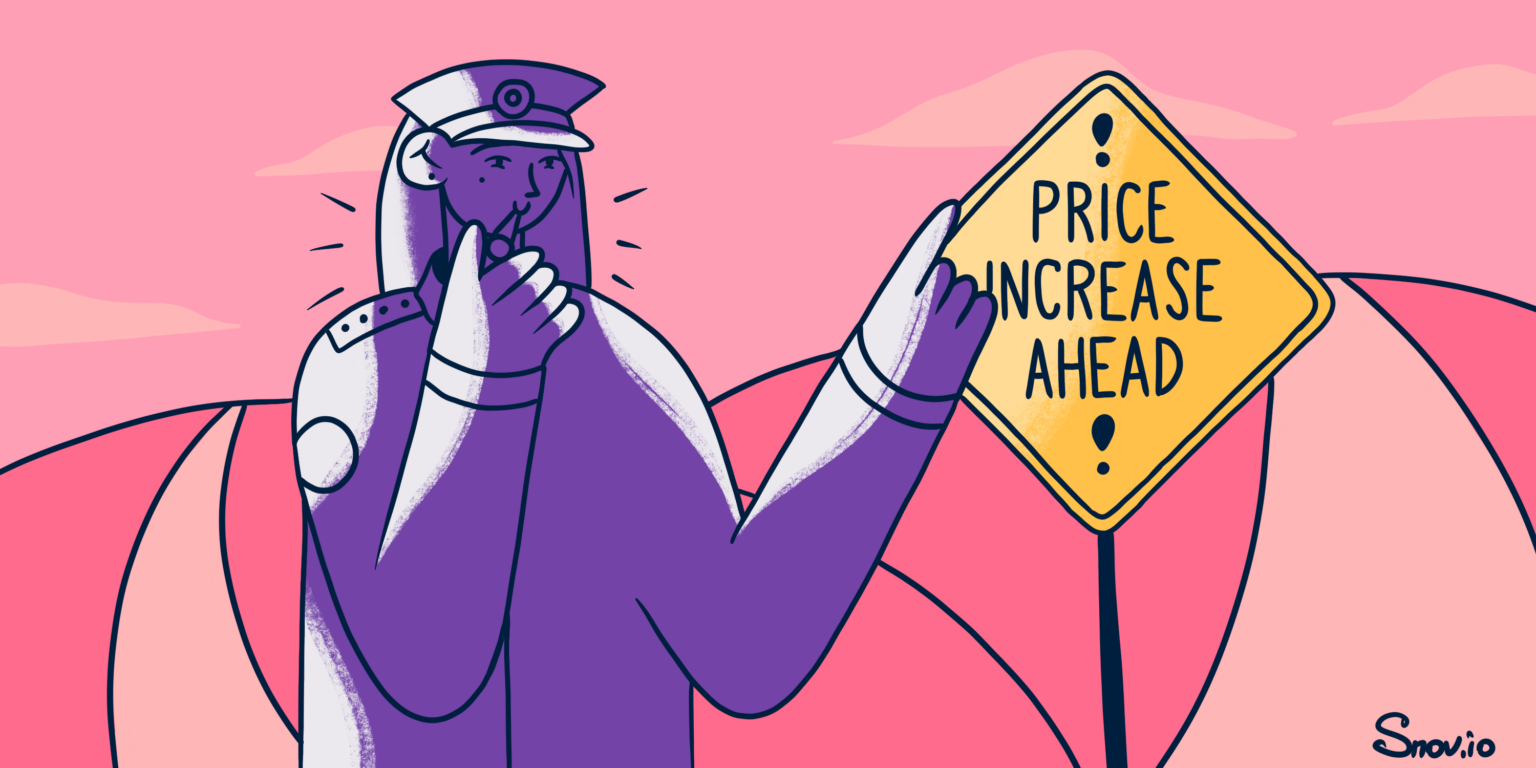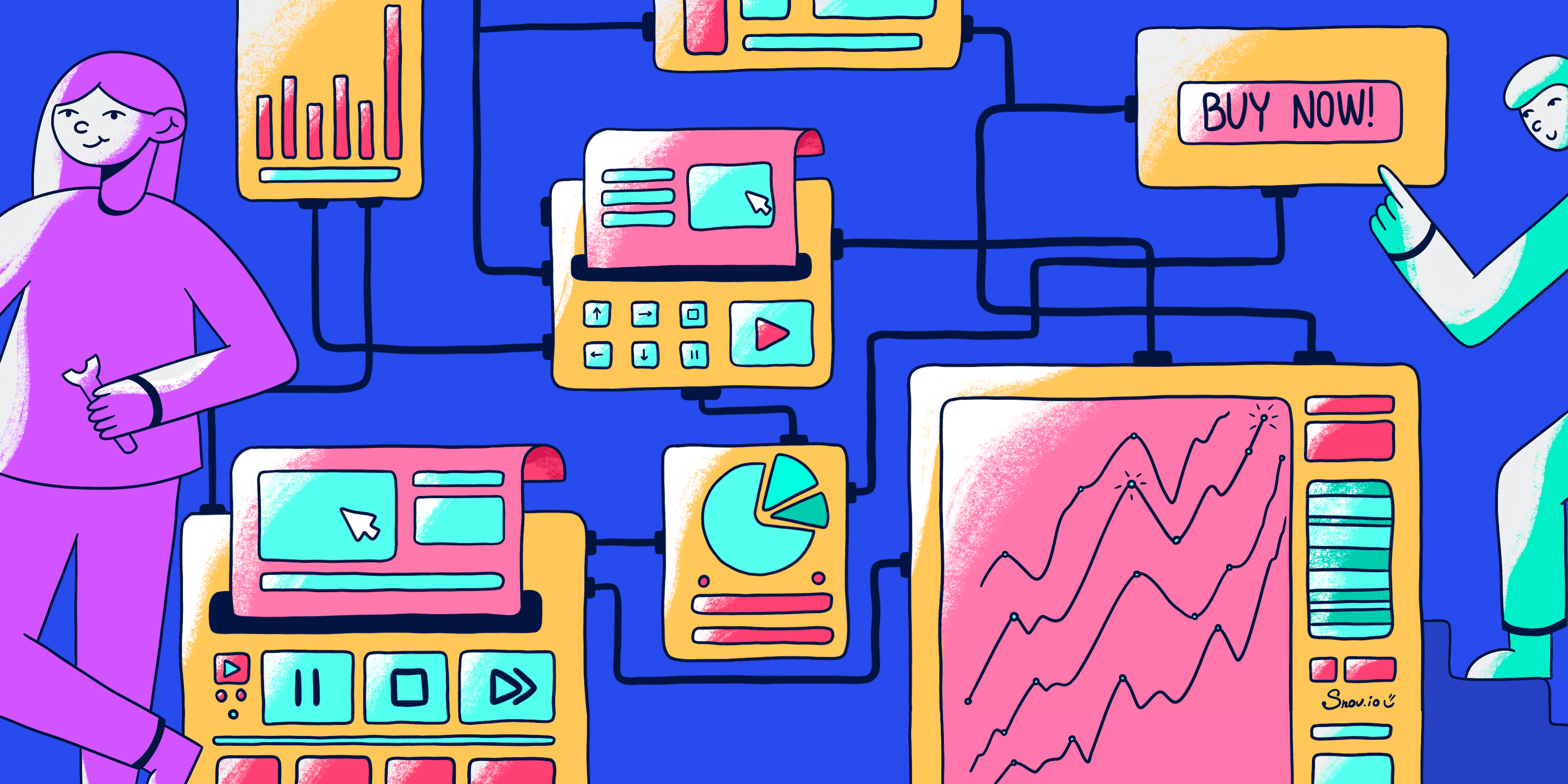For every business there comes a time when for one reason or the other you need to raise your prices. The biggest argument in support of price increase is higher revenue. The biggest argument against is always customer backlash.
In this post, we’ll share some tips on how to craft a price increase letter that will get the disgruntled customer on your side and smoothen the transition to new pricing plans.
Here are our 8 recommendations on how to write a price increase email:
1. Don’t tiptoe around it
If you have to raise prices – do it, no need to be apologetic. This will only confuse your customers about the intent of the increase and, more importantly, the letter. And the intent is to announce and explain, not appease them. Being direct will help you avoid that air of hesitation that often plagues price increase emails.
You may ask, what’s so bad about being honest? As soon as the clients think you are not 100% sure why you’re increasing the pricing or whether you even want to, they’ll try to get you to delay the increase, make an exception just for them, or even cancel the increase altogether. It’s likely that you don’t have the time to deal with that.
Stand your ground and don’t go around in circles. Instead of apologizing, get to the next point – value.
2. Justify through value
Any statement, decision, or conclusion your company makes has likely passed through multiple meetings before being announced. Use the arguments behind your decision to raise prices in the email (revealing only as much as you can, of course). Explain what value you’ll be able to bring using the additional revenue.
Don’t have anything exciting to announce? Not a problem — everything anything can be turned into a positive piece of news. Had to raise prices because you couldn’t afford to move to better servers? Announce that your service “will direct the growth in revenue towards new faster servers that will significantly improve service performance”. Feel like you’re missing out on revenue by offering unlimited freemiums? Explain that this step in your business strategy will give a long-needed boost that will allow discovering all the exciting new plans you have in store for your loyal clients.
If you work in the B2C niche, the price increase of the product can be caused by the rising costs of production. While your customers may not necessarily care about that, they care about ethical consumption. Explain that the price increase will let you avoid sacrificing quality or using exploitative underpaid labor – in fact, by supporting you, clients will make their contribution to fair pay and the ethical labor movement.
You should never lie in your price increase emails. Don’t promise something you never intend to deliver. When you do launch the improvements, features, or products you’ve promised, it’s a good idea to give your customers an update to reconfirm that you’ve delivered what was promised.
3. Avoid essay-ing
What I love to emphasize every time I write about how to create an email is the email length.
Don’t write long emails. Please.
There’s only a handful of occasions when a long email may be a good idea, but a price increase email ain’t it. Present all the key points in short, don’t turn it into an essay about the philosophy behind the concept of price.
What you may want to do instead (if you want to avoid dedicating the whole email to the pricing change) is announce it alongside other updates: for example, say, giving 4 updates and the price increase announcement; write the letter to customers about the price increase only up to 10 sentences long including greeting, four improvements (separate sentence for each), pricing change information, a line about how to get back to you, and a sign-off. Short and clear.
4. Make sure your emails are human-like
Being passive, even in routine emails like this one, will be met with just the same attitude from the recipients. And apathy is an email marketer’s biggest enemy. You are not an email sending machine. You are a real person communicating with other people, so don’t strip your email of that humanity.
Show your appreciation for customers by showing a more human side of your business, offering to answer their questions, and making an email seem like a one-on-one conversation in any way you can.
“Build relationships” is one of the oldest (and frankly, most overused) advice, but it is for a reason. Even in a price increase letter, giving a customer a way to contact you, to express their ideas regarding your service or product, to let them know that you want to hear from them is one of the easiest ways to gain loyalty.
5. Personalize the email
It’s not 2003 and addressing people by their name in an email is no longer an Aladdin’s lamp to make recipients feel special. There are many other ways you can do that; for instance, you may personalize emails based on customer’s location or demographics. To compare, 66% of marketers utilize age data to personalize their messages.
Yet, personalization is no longer just about the data you have about the recipient either. It’s an individual approach. Kindness. Respect.
Of course, the level of personalization will depend on the size of your customer base – you may have 10 big clients or 100,000 customers. Needless to say, letters to the former should get individually crafted and hyper-personalized, even if you’re automating your emails. However, if your customer base is too big to apply an individual approach indeed, focus on making your email seem easy. “Easy” means not forced, but casual, easy-to-read, and genuine. This is easier to achieve if the emails are sent from an individual’s account (CEO, for example) and not from a nameless and faceless “team” account.
Let’s look at these two price increase letter examples a little closer to see what exactly is working and what’s not.
This letter works, and here’s why:
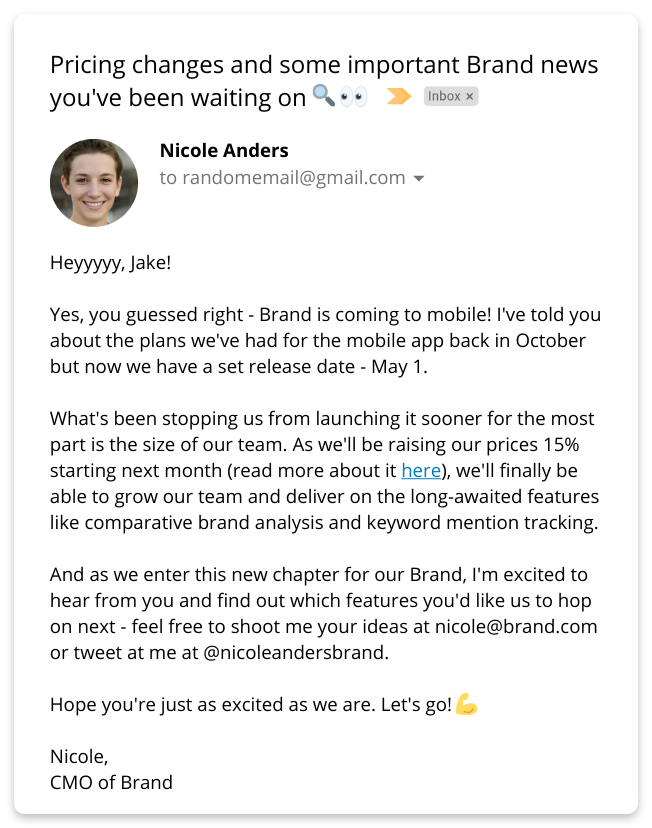
✔️ You can see the face and name of the person that’s addressing you
✔️ Casual greeting and tone switch off the official mindset with which you’d usually read brand emails
✔️ Price increase is mentioned easily and naturally written into positive news
✔️ Value is described in great detail
✔️ Sender gives a couple of ways to contact them personally with ideas and opinions
✔️ Overall, a person is writing to you about company news, not a company is reporting on company news.
Now let’s check a less successful example. This rate increase letter doesn’t work for a couple of easily avoidable reasons:

❌ No personal details of the sender
❌ Value described too vaguely
❌ No details on how to contact the team
❌ This email should have been segmented for those who have purchased monthly and yearly plans
❌ It comes off as too automatic, “dry”, and impersonal
Some may argue that the friendliness of the first example is artificial – after all, it’s still a company announcing brand news. But I will argue for such copywriting style any day. If you can make me get excited about bad news, that’s one less thing that will stress me out that day and another positive thing I will associate with your company.
As you can see, it’s not really about the {{name}}.
6. Set the deadline & use a call-to-action to get a boost in revenue
If you still worry about dealing with backlash, you can use a distraction to turn negative news into a savings opportunity. Here’s how.
Don’t announce an immediate rate increase. Set a deadline for at least 30 days from the announcement date and give your customers an opportunity to buy/subscribe at the old rate. Again, give a specific deadline for this savings opportunity, and throw in a little perk if possible. A perk can be an option to buy a 3-months subscription at the old price instead of only allowing 1 month before the price increase.
You may even want to throw in an option to buy an annual plan at the old price, which works pretty well for SaaS companies. This will give you a revenue boost before the actual price increase and engage customers into staying with you for longer.
7. Let customers reach you back
It’s very important to include in your price increase letter a line about your accessibility in case customers have any questions after they receive this portion of news from you. Assure them they can always contact someone in your team with questions about the price updates.
In a scenario when you are not going to compose a long-read email with tons of information and limit to the main points, your customers must count on getting more information per their inquiry whenever they have it. Otherwise, some clients, finding themselves with not enough explanation from you, may turn to your competitors, and you’d never wish it happened, wouldn’t you?
8. Segment the recipients
Every customer is unique. There are at least two categories of clients you will have: free users and paying clients.
Divide your client base into groups and create variations of your price increase letter to customers according to their status. In basic terms, your clients are at different stages of the buyer’s journey and you should use a different approach for each stage and category. This will let you retain paying and convert free users easier.
We recommend splitting the clients into at least three groups: users on a free subscription plan, clients paying monthly, and subscribers with yearly plans. Compose the copies according to the peculiarities of each group and their objections and issues.
Price increase letter examples
There are a lot of price increase letter examples online (like these B2C ones); however, we recommend not using price increase letter templates but rather use them as an inspiration.
So here are some price increase email letters to inspire you:
Example #1: SaaS subscription service
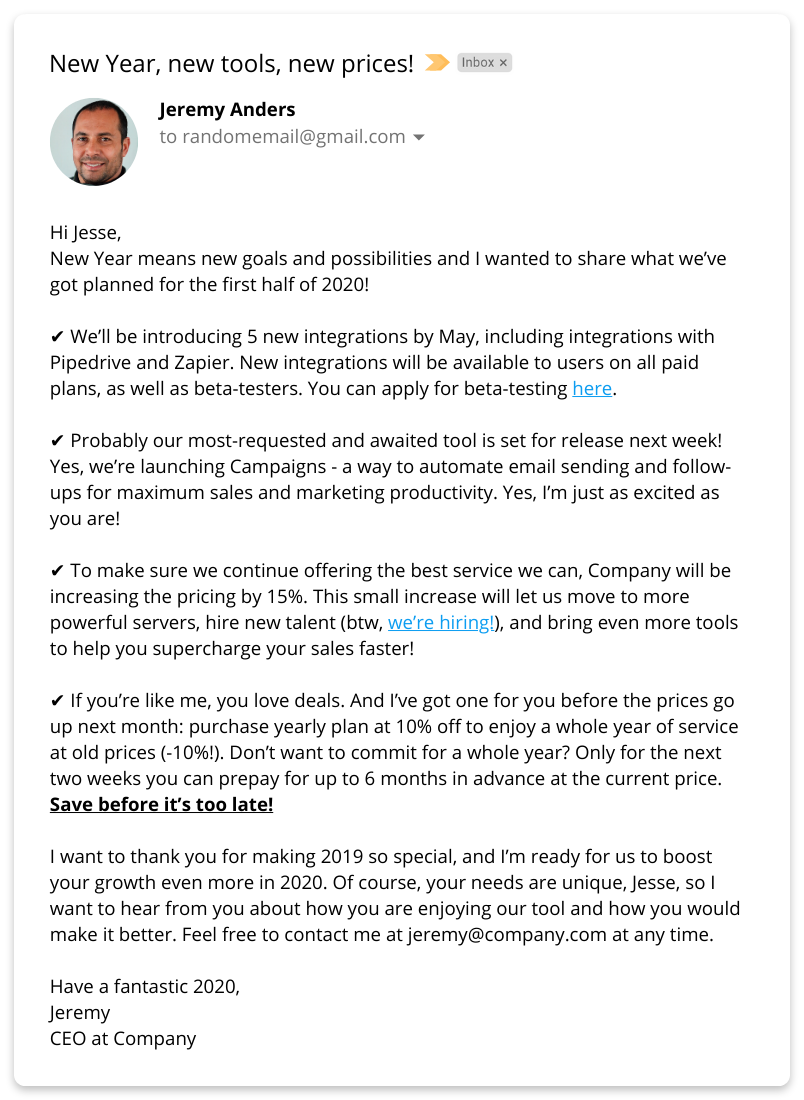
Example #2: B2C retail
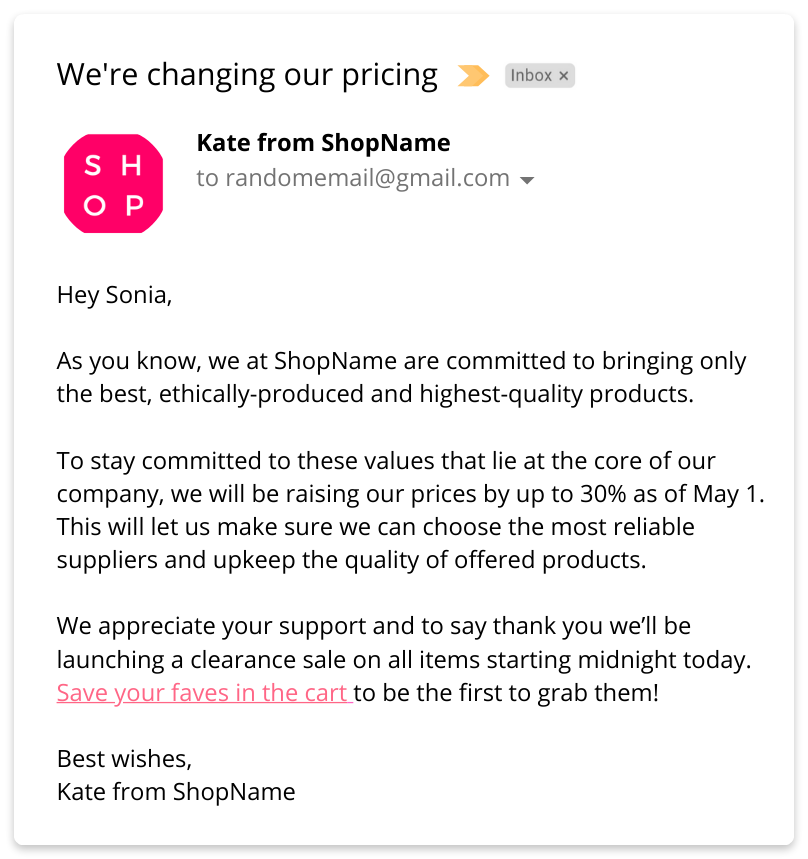
Example #3: Loyal clients
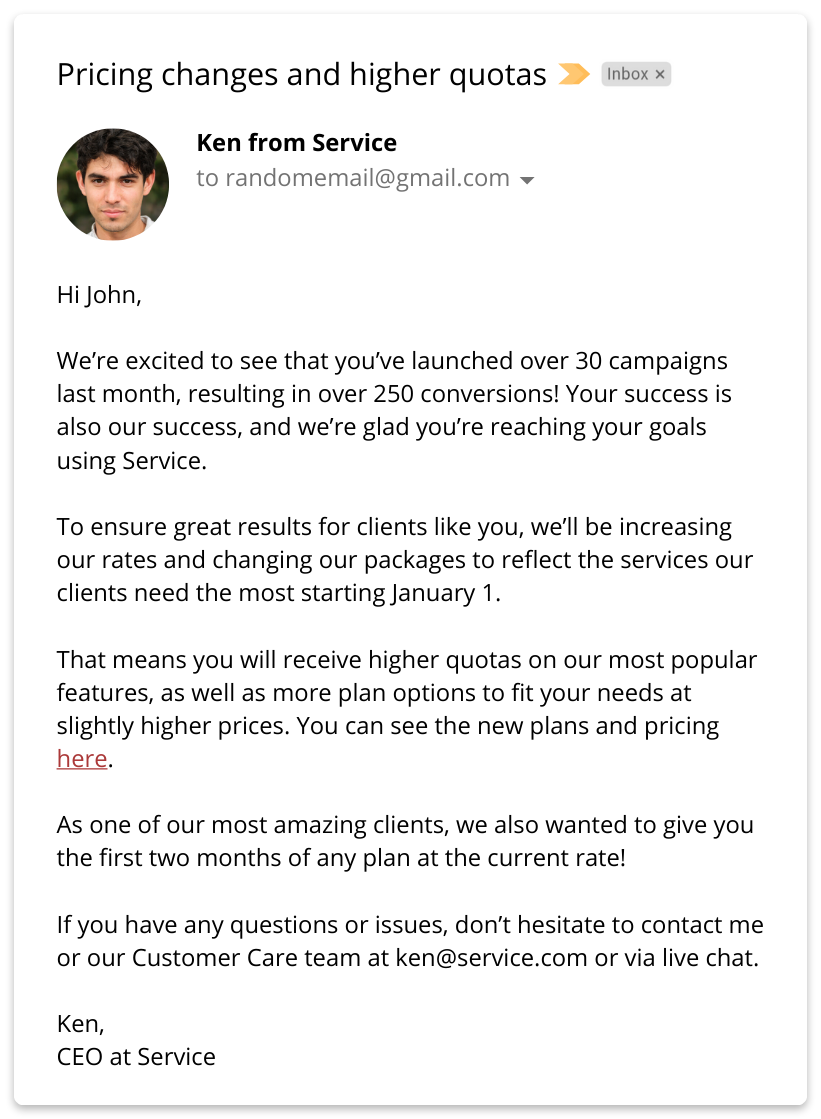
Example #4: Free users price increase letter
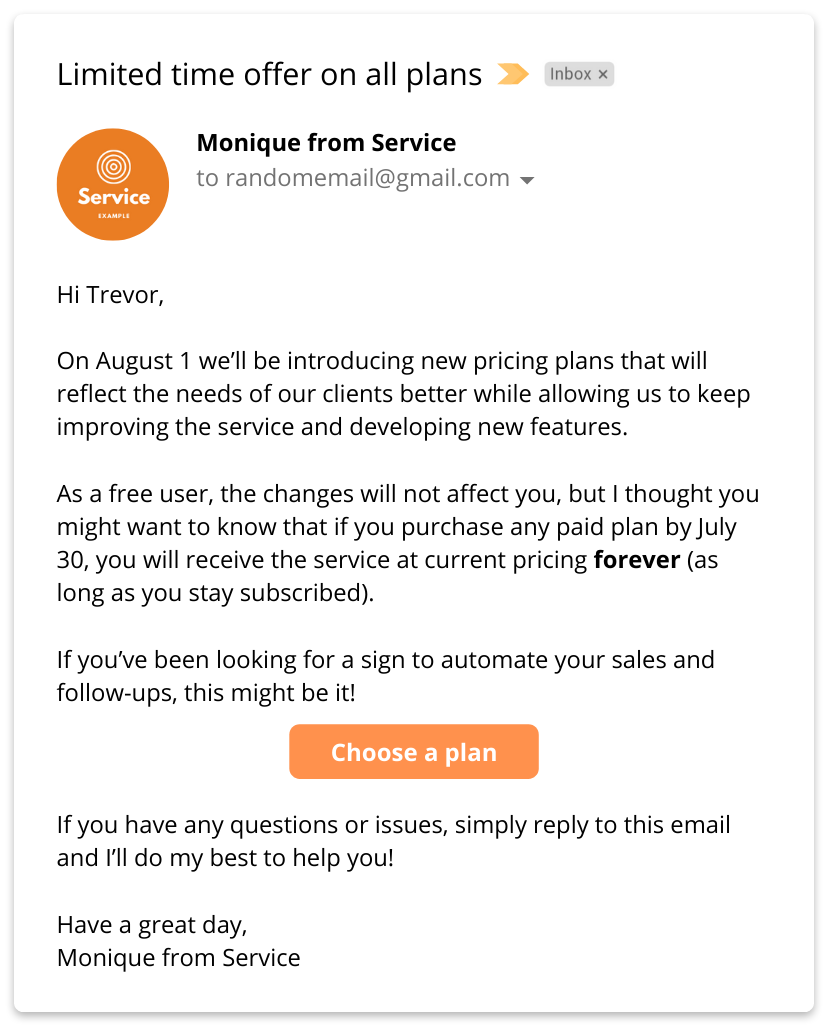
Example #5: Segmented price increase letter
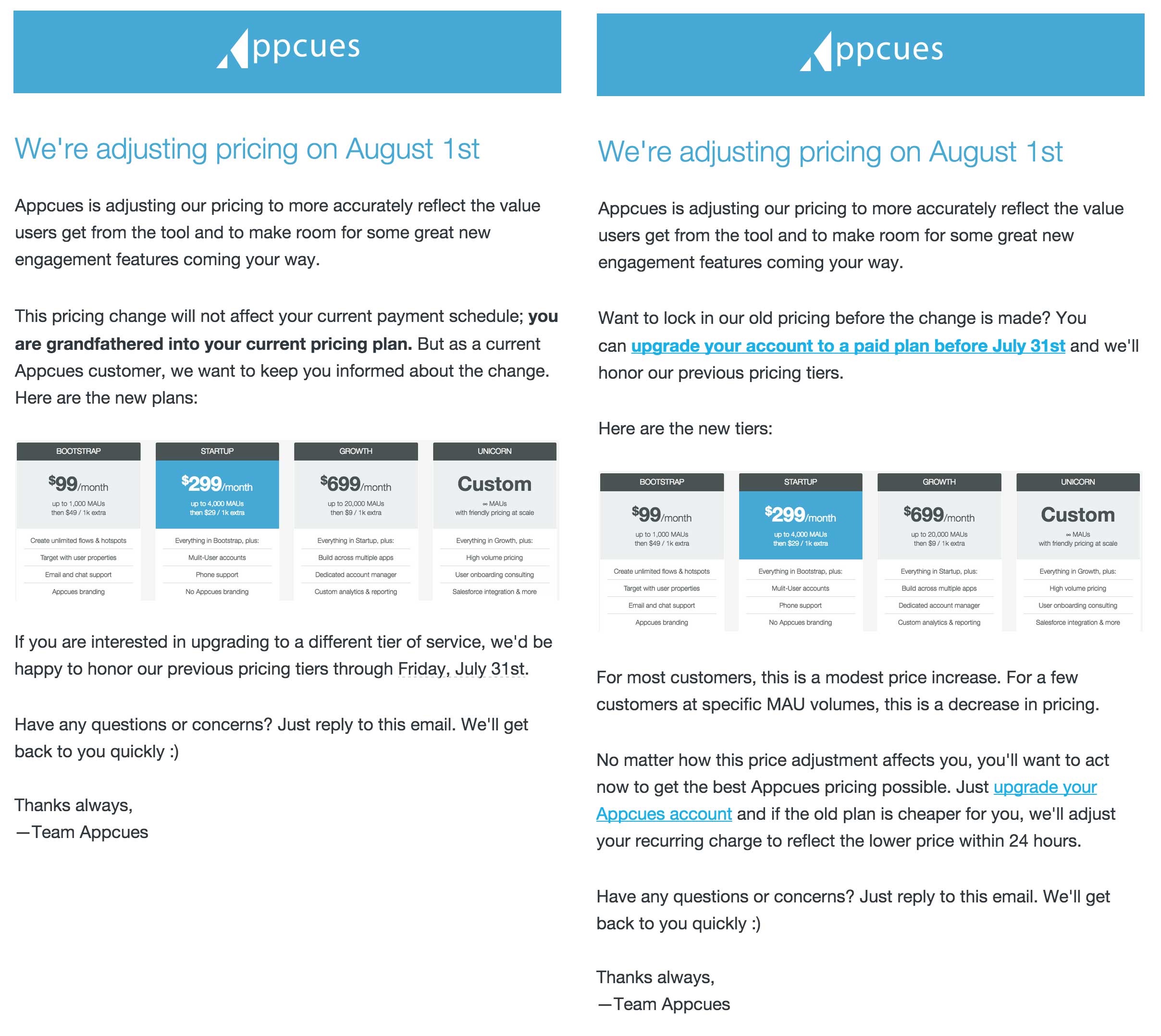
Don’t be afraid
The hardest part of increasing prices is managing customer backlash. But it’s not that complicated if you just keep in mind these short simple rules:
- show certainty in your decision and keep pushing on
- explain how the price increase will be valuable for the customers
- keep it brief
- open a genuine, personal, one-on-one conversation and give users a way to contact you
- consider offering a special deal for a pre-increase revenue boost
- segment and personalize
Know a price increase letter tip we haven’t mentioned? Let us know in the comments.
And don’t forget to always verify email lists to ensure your emails always hit the inbox!
